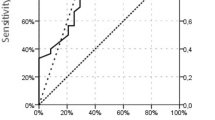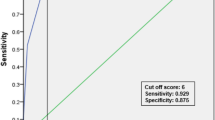Abstract
The purpose of our study is to analyze the definitive relation of C-reactive protein (CRP) and other factors with the spontaneous stone passage in patients with distal ureteric calculus of 5–10 mm and to calculate the risk of failure of expectant management in patients. 185 patients of ureteric colic, who were subjected to medical expulsive therapy (MET), were included prospectively from August 2016 to May 2018 and followed up for 4 weeks. Patients were divided into two groups. Group A included successful spontaneous passage patients and group B included failure in the same. The parameters analyzed were age, gender, longitudinal and transverse diameter of stone, CRP, total leucocyte count, ureteric diameter and hydroureteronephrosis (HUN). We performed univariate and multivariate analysis. Receiver operating characteristics curve was used to determine the cutoff value for significantly associated variables. 122 (65.90%) and 63 (34.10%) patients were included in group A and B, respectively. In univariate analysis, CRP, longitudinal and transverse diameter of stone, HUN, proximal and distal ureteric diameters were statistically significant. However, in multivariate analysis, only negative CRP (p = 0.002), smaller longitudinal diameter of stone (p < 0.001) and absence of HUN (p = 0.005) were significantly associated with successful expulsion. Cutoff for CRP was 0.41 mg/dl and longitudinal diameter was 6.7 mm. The success rate in the group of patients with no risk factor was 96.7% and with all three risk factors was 16.7%. Patients with a longitudinal diameter of stone > 6.7 mm, HUN, and CRP > 0.41 mg/dl should be considered for early intervention. The success rate of MET can be increased to 86% after exclusion of patients with all three risk factors.


Similar content being viewed by others
References
Rukin N, Siddiqui Z, Chedgy E, Somani B (2016) Trends in upper tract stone disease in England: evidence from the hospital episodes statistics database. Urologia Internationalis 98(4):391–396
Elton T, Roth C, Berquist T, Silverstein D (1993) A clinical prediction rule for the diagnosis of ureteral calculi in emergency departments. J Gen Intern Med 8(2):57–62
Dellabella M, Milanese G, Muzzonigro G (2003) Efficacy of tamsulosin in the medical management of juxtavesical ureteral stones. J Urol 170(6):2202–2205
Wang H, Man L, Huang G, Li G, Wang J (2016) Comparative efficacy of tamsulosin versus nifedipine for distal ureteral calculi: a meta-analysis. Drug Des Dev Ther 10:1257–1265
Sfoungaristos S, Kavouras A, Perimenis P (2011) Predictors for spontaneous stone passage in patients with renal colic secondary to ureteral calculi. Int Urol Nephrol 44(1):71–79
Celik S, Akdeniz F, Yildirim M, Bozkurt O, Bulut M, Hacihasanoglu M et al (2017) Computed tomography findings predicting the success of silodosin for medical expulsive therapy of ureteral stones. Kaohsiung J Med Sci 33(6):290–294
Ahmed A, Al-Sayed A (2010) Tamsulosin versus alfuzosin in the treatment of patients with distal ureteral stones: prospective, randomized, comparative study. Korean J Urol 51(3):193
Furyk J, Chu K, Banks C, Greenslade J, Keijzers G, Thom O et al (2016) Distal ureteric stones and tamsulosin: a double-blind, placebo-controlled, randomized multicenter trial. Ann Emerg Med 67(1):86–95.e2
Hollingsworth J, Canales B, Rogers M, Sukumar S, Yan P, Kuntz G et al (2016) Alpha blockers for treatment of ureteric stones: systematic review and meta-analysis. BMJ 355:i6112
Wang C, Huang S, Chang C (2008) Efficacy of an α1 blocker in expulsive therapy of lower ureteral stones. J Endourol 22(1):41–46
Savić S, Vukotić V, Lazić M, Savić N (2014) Management of calculus anuria using ureteroscopic lithotripsy as a first line treatment: its efficacy and safety. Urol J 11(2):1392–1399
Pepys M, Hirschfield G (2003) C-reactive protein: a critical update. J Clin Investig 111(12):1805–1812
Özcan C, Aydoğdu O, Senocak C, Damar E, Eraslan A, Oztuna D et al (2015) Predictive factors for spontaneous stone passage and the potential role of serum C-reactive protein in patients with 4 to 10 mm distal ureteral stones: a prospective clinical study. J Urol 194(4):1009–1013
Sfoungaristos S, Kavouras A, Katafigiotis I, Perimenis P (2012) Role of white blood cell and neutrophil counts in predicting spontaneous stone passage in patients with renal colic. BJU Int 110(8b):E339–E345
Park C, Ha J, Park C, Kim C, Kim K, Kim B (2013) Relationship between spontaneous passage rates of ureteral stones less than 8 mm and serum C-reactive protein levels and neutrophil percentages. Korean J Urol 54(9):615
Lee K, Ha J, Koo K (2017) Significance of neutrophil-to-lymphocyte ratio as a novel indicator of spontaneous ureter stone passage. Yonsei Med J 58(5):988
Miller O, Kane C (1999) time to stone passage for observed ureteral calculi: a guide for patient education. J Urol 162(3):688–691
Paajanen H, Tainio H, Laato M (1996) A chance of misdiagnosis between acute appendicitis and renal colic. Scand J Urol Nephrol 30(5):363–366
Sandberg T, Lidin-Janson G, Edén C (1989) Host response in women with symptomatic urinary tract infection. Scand J Infect Dis 21(1):67–73
Shaoul R, Lahad A, Tamir A et al (2008) C-reactive protein (CRP) as a predictor for true bacteremia in children. Med Sci Monit 14:CR255–CR261
Horcajada J, Velasco M, Filella X, Alvarez L, De Lazzari E, Marin J et al (2004) Evaluation of inflammatory and renal-injury markers in women treated with antibiotics for acute pyelonephritis caused by Escherichia coli. Clin Vaccine Immunol 11(1):142–146
Aldaqadossi H (2013) Stone expulsion rate of small distal ureteric calculi could be predicted with plasma C-reactive protein. Urolithiasis 41(3):235–239
Hada A, Yadav SS, Tomar V, Priyadarshi S, Agarwal N, Gulani A (2018) Assessment of factors affecting the spontaneous passage of lower ureteric calculus on the basis of lower ureteric calculus diameter, density, and plasma C-reactive protein level. Urol Ann 10:302–307
Angulo J, Gaspar M, Rodríguez N, García-Tello A, Torres G, Núñez C (2010) The value of C-reactive protein determination in patients with renal colic to decide urgent urinary diversion. Urology 76(2):301–306
McSorley S, Drury M, Majumdar P, Halsall A, Nalagatla S (2013) C-reactive protein to predict the need for surgical intervention in acute renal colic. J Clin Urol 7(6):380–383
Lee S, Jeon H, Park D, Choi Y (2012) Longitudinal stone diameter on coronal reconstruction of computed tomography as a predictor of ureteral stone expulsion in medical expulsive therapy. Urology 80(4):784–789
Hwang E, Kim Y, Yuk S, Sul C, Lim J (2010) Factors that predict spontaneous passage of a small distal ureteral stone %3c 5 mm. J Endourol 24(10):1681–1685
Hiller N, Berkovitz N, Lubashevsky N, Salaima S, Simanovsky N (2012) The relationship between ureteral stone characteristics and secondary signs in renal colic. Clin Imaging 36(6):768–772
Funding
This study was not funded by any agency.
Author information
Authors and Affiliations
Corresponding author
Ethics declarations
This study is highly compliant without variation from Ethical Standard. Annual progression reports are submitted to the institutional ethical committee.
Conflict of interest
None of the authors have any conflict of interest.
Ethical approval
All procedures performed in studies involving human participants were in accordance with the ethical standards of the institutional research committee and also the 1964 Helsinki declaration and its later amendments or comparable ethical standards. Ethical approval was obtained for the study on 05/07/2016 (JIP/IEC/2016/27/884).
Informed consent
Informed consent was obtained from all individual participants included in the study.
Additional information
Publisher's Note
Springer Nature remains neutral with regard to jurisdictional claims in published maps and institutional affiliations.
Rights and permissions
About this article
Cite this article
Jain, A., Sreenivasan, S.K., Manikandan, R. et al. Association of spontaneous expulsion with C-reactive protein and other clinico-demographic factors in patients with lower ureteric stone. Urolithiasis 48, 117–122 (2020). https://doi.org/10.1007/s00240-019-01137-x
Received:
Accepted:
Published:
Issue Date:
DOI: https://doi.org/10.1007/s00240-019-01137-x




